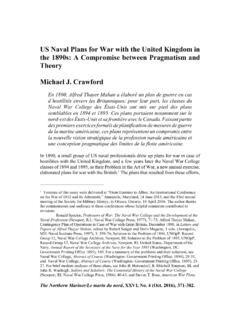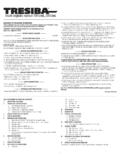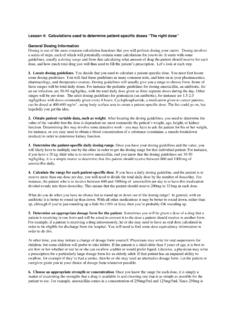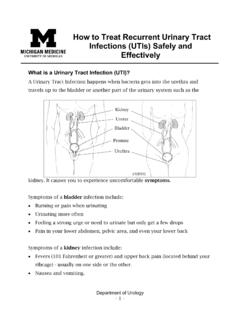Transcription of Corpsman Up! - United States Navy
1 Corpsman Up! In this packet, we will be learning about what roles Navy hospital corpsmen played in World War II! By learning about their history, we can better understand and appreciate the work they do today. Contact the National Museum of the Navy for Field Trip and School Visit opportunities! *This packet is intended for elementary schools, to be used in groups of three or fewer and/or individually. 1. What is a Corpsman ? The Navy and the Marine Corps do not have medics, they have corpsmen. Navy corpsmen get their names from the Navy's Hospital Corps.
2 Established in 1898, the Hospital Corps gave the Navy the ability to give enlisted sailors formal medical training. Corpsmen assist doctors on board ships and submarines, and some are attached to Marine units. When in combat, corpsmen are trained to run towards the action to help the wounded, often risking their own lives to do so. During World War II, hundreds young men became corpsmen mostly by chance. Some even requested completely different jobs! Many did not have any medical training or experience before enlisting in the Navy.
3 That meant they had to learn everything from the ground up. After passing their Navy training, they would move on to Hospital Corps school, where they learned things like first aid, anatomy, and hygiene. They would also learn how to operate medical equipment like x-ray machines. Finally, corpsmen would be assigned to Navy hospitals, ships, or Navy air centers to put these skills to use. A select few of these would then be sent to the Marines. Beginning in World War II, corpsmen who served with the Fleet Marine Force would go through boot camp with the Marine Corps.
4 This gives them the skills they need to act as a field medic on the battlefield. They were also trained in combat skills to protect themselves and their comrades if necessary. In the field, these Fleet Marine Force (FMF) corpsmen helped provide emergency first aid to wounded Marines. By quickly disinfecting and bandaging wounds, treating burns, and setting broken bones, corpsmen helped ensure their buddies would survive the trip from the battlefield to a hospital ship. Corpsmen would often help lead the wounded back to aid stations, where Navy doctors could provide more intensive care.
5 Wounded Marines would then be sent to a hospital ship, and finally a Navy hospital for recovery. Corpsmen serving in hospitals and on-board ships usually provided routine medical care, but were sometimes asked to preform medical miracles! Most famously, submarines on war patrols carried a well trained corpsmen, but no doctor. While hunting for enemy ships, submarines cannot surface whenever they want to, and they are often far away from any friendly ships or ports to ask for help. During World War II, hospital corpsmen had to preform emergency operations to remove a submariner's appendix without the help of a licensed doctor three different times!
6 Did you know? Navy corpsmen are often nicknamed Doc . by the people they serve with. 2. Corpsmen in WWII. Guiding Question: In wartime, both sides usually try to avoid purposely attacking Do you think you could be a Navy medical personnel. According to the Geneva Conventions, any Corpsman ? What skills would you doctors, medics, nurses, or corpsmen are not supposed to carry need to have to be a good weapons, and must display a red cross insignia on their person or Corpsman ? helmet to show they are a noncombatant. While these rules were usually respected in Europe, corpsmen serving in the Pacific quickly learned that anything that showed they were a medic could put them at risk.
7 The Japanese liked to target corpsmen and Army medics, as well as doctors. They knew if they hurt or killed someone with medical training, they wouldn't be able to help other wounded Marines or soldiers. They also knew that both Marines and soldiers might be more willing to risk their lives to help save a Corpsman or medic. Corpsmen serving with the Marines were trained to use weapons just as well as a Marine and often carried firearms into combat, even if they did not use them during battle. They wore the same uniforms as their Marine buddies and tried to blend in as much as possible.
8 This made it harder for the Japanese to tell who was a Corpsman and who was a regular Marine. On many occasions, corpsmen had to use weapons to help protect the wounded or themselves. Corpsmen in the Pacific also had to battle dangerous diseases like malaria, dysentery, and beriberi. They helped treat the diseases, and tried to prevent the spread of them by giving medicine to Marines. Some corpsmen were asked by their commanding officers to give talks about first aid and field medicine to groups of Marines before they went into battle.
9 This helped Marines know how to keep themselves and their buddies safe in case a Corpsman couldn't get to them quickly. Although most corpsmen saw combat with the Marines in the Pacific or on Navy vessels around the world, many participated in amphibious landings in the European theater as well. They set up beach aid stations and provided first aid to wounded soldiers in North Africa, Italy, and Normandy. No matter where they served, corpsmen were trusted and relied on by their comrades. Some men would even tell corpsmen their secrets and worries about the war and their lives back home.
10 Corpsmen were also trained to help treat battle fatigue , what we now know as Post Traumatic Stress. In places like Normandy, the Philippines, and Okinawa, corpsmen would also do what they could to help civilians caught in the middle of battles. Did you know? Atabrine helped prevent malaria, but the pills tasted so bitter, many people hated taking them! Corpsmen would sometimes watch to make sure the pills were actually being swallowed. 3. Uniforms When serving on a Navy ship or at a Navy hospital, corpsmen wore the same uniforms as other enlisted sailors.

















